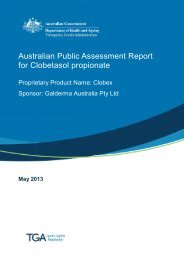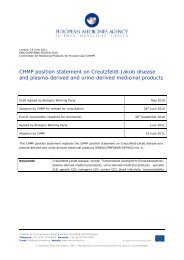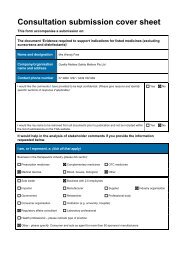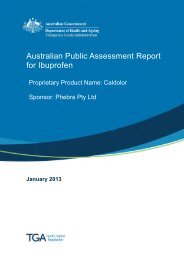AusPAR: Ivabradine - Therapeutic Goods Administration
AusPAR: Ivabradine - Therapeutic Goods Administration
AusPAR: Ivabradine - Therapeutic Goods Administration
You also want an ePaper? Increase the reach of your titles
YUMPU automatically turns print PDFs into web optimized ePapers that Google loves.
<strong>AusPAR</strong> Coralan <strong>Ivabradine</strong> Servier Laboratories (Australia) Pty Ltd PM-2010-03269-3-3<br />
Final 31 October 2012<br />
<strong>Therapeutic</strong> <strong>Goods</strong> <strong>Administration</strong><br />
between the treatment groups. Among protocol deviations before or at inclusion which<br />
could have impacted the efficacy assessment, the highest incidence in both treatment<br />
groups was the deviation involving “no documented hospitalisation for worsening heart<br />
failure within 12 months prior to selection” (1.3% [43/ 3241] and 1.1% [37/ 3264] in the<br />
ivabradine and placebo treatment groups, respectively).<br />
The disposition of protocol deviations occurring during the study, by category and by<br />
treatment group showed that overall, 132 patients presented at least one protocol<br />
deviation during the study: 69 patients (2.1%) in the ivabradine group and 63 patients<br />
(1.9%) in the placebo group. Overall, 149 protocol deviations were detected during the<br />
study, with 147 deviations which could have impacted the safety assessment and 2<br />
deviations which could have impacted the study management. There were no deviations<br />
observed that could have affected the efficacy assessment.<br />
Baseline data<br />
The baseline demographic characteristics were comparable between the 2 treatment<br />
groups. The overall mean age (± SD) was 60.4 (± 11.4) years with a range from 19 to 92<br />
years. Overall, 38.0% (2474/ 6505) were ≥ 65 years of age and 11.1% (722/ 6505) were<br />
≥75 years of age. The majority of patients were male (76.4%) and Caucasian (88.7%). The<br />
overall mean (± SD) heart rate was 79.9 (± 9.6) bpm, with a range of 48 to 142 bpm. The<br />
baseline heart rate was < 80 bpm in 59.9% of patients, between 80 to 89 bpm in 24.4% of<br />
patients and ≥ 90 bpm in 15.6% of patients.<br />
The main baseline CHF disease characteristics were comparable between the 2 treatment<br />
groups. The overall mean (± SD) duration of the CHF from diagnosis was 3.5 (± 4.2) years,<br />
with a median of 2.0 years. Overall, 50.2% of the study population had a duration of CHF of<br />
< 2 years, 25.7% for ≥2 to 25 to<br />
≤0%, 15.3% with LVEF of >20 to ≤ 25%, and 9.5% with LVEF of ≤ 20%. Only 0.1% had an<br />
LVEF of > 35% (protocol violation).<br />
Main background treatments for heart failure were comparable between the 2 treatment<br />
groups. Overall, the majority of patients (89.5%, 5820/6505) were taking a beta blocker at<br />
randomisation. The most frequent reason for the non prescription of a beta blocker at<br />
randomisation was chronic obstructive pulmonary disease (COPD) (34.5% among patients<br />
not on beta blocker at randomisation), followed by hypotension (18.5%) and asthma<br />
(10.9%). Among patients taking a beta blocker at randomisation, 98.2% were taking one<br />
of the ESC recommended drugs or metoprolol tartrate. Overall, 55.7% of these patients<br />
taking a recommended drug or metoprolol tartrate were taking at least half the target<br />
daily dose, and 26.1% were taking the recommended target daily dose. The main reasons<br />
for not being at the target daily dose were hypotension (44.6%) or fatigue (31.9%).<br />
Overall treatment compliance, mean treatment dose and dose titration profiles showed<br />
that overall 97.8% of patients had a global compliance of between 70% and 130% 20 and<br />
this was comparable between the 2 treatment groups (97.5% and 98.1% of patients in the<br />
ivabradine and placebo groups, respectively). The overall mean (± SD) global compliance<br />
was 96.3% ± 10.2% (96.2% ± 11.3% and 96.4% ± 9.0% in the ivabradine and placebo<br />
groups, respectively). In the ivabradine group, 60.3% of patients were up-titrated from the<br />
20 Global compliance (%) was calculated as (Σ number of tablets taken / (duration of treatment x 2)) x 100<br />
Page 18 of 101
















